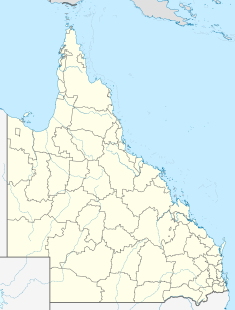War Memorial Bridge, Brooweena
| War Memorial Bridge, Brooweena | |
|---|---|
| Location | Brooweena-Woolooga Road, Brooweena, Fraser Coast Region, Queensland, Australia |
| Coordinates | 25°44′16″S 152°14′09″E / 25.7378°S 152.2358°ECoordinates: 25°44′16″S 152°14′09″E / 25.7378°S 152.2358°E |
| Design period | 1919 - 1930s (interwar period) |
| Built | 1921 |
| Architect | Lawrence Stevens Smith |
| Official name: War Memorial Bridge | |
| Type | state heritage (built) |
| Designated | 21 October 1992 |
| Reference no. | 600968 |
| Significant period | 1920s (fabric) 1921-1972 (historical use as bridge) |
| Significant components | pier/s (bridge), memorial - cairn, memorial - plaque, memorial - pillar/s |
| Builders | Frederick William Webb |
War Memorial Bridge is a heritage-listed memorial bridge at Brooweena-Woolooga Road, Brooweena, Fraser Coast Region, Queensland, Australia. It was designed by Lawrence Stevens Smith and built in 1921 by Frederick William Webb. It was added to the Queensland Heritage Register on 21 October 1992.
The Brooweena War Memorial Bridge was officially opened on 21 May 1921 by local clergyman the Rev Hardingham. Mrs A Brown, whose son was among the fallen, performed the unveiling of the honour roll. The memorial honours the 9 local men who fell during the First World War.
Australia, and Queensland in particular, had few civic monuments before the First World War. The memorials erected in its wake became our first national monuments, recording the devastating impact of the war on a young nation. Australia lost 60 000 from a population of about 4 million, representing one in five of those who served. No previous or subsequent war has made such an impact on the nation.
Even before the end of the war, memorials became a spontaneous and highly visible expression of national grief. To those who erected them, they were as sacred as grave sites, substitute graves for the Australians whose bodies lay in battlefield cemeteries in Europe and the Middle East. British policy decreed that the Empire war dead were to be buried where they fell. The word "cenotaph", commonly applied to war memorials at the time, literally means "empty tomb".
Australian war memorials are distinctive in that they commemorate not only the dead. Australians were proud that their first great national army, unlike other belligerent armies, was composed entirely of volunteers, men worthy of honour whether or not they made the supreme sacrifice. Many memorials honour all who served from a locality, not just the dead, providing valuable evidence of community involvement in the war. Such evidence is not readily obtainable from military records, or from state or national listings, where names are categorised alphabetically or by military unit.
Australian war memorials are also valuable evidence of imperial and national loyalties, at the time, not seen as conflicting; the skills of local stonemasons, metalworkers and architects; and of popular taste. In Queensland, the soldier statue was the popular choice of memorial, whereas the obelisk predominated in the southern states, possibly a reflection of Queensland's larger working-class population and a lesser involvement of architects.
...
Wikipedia


